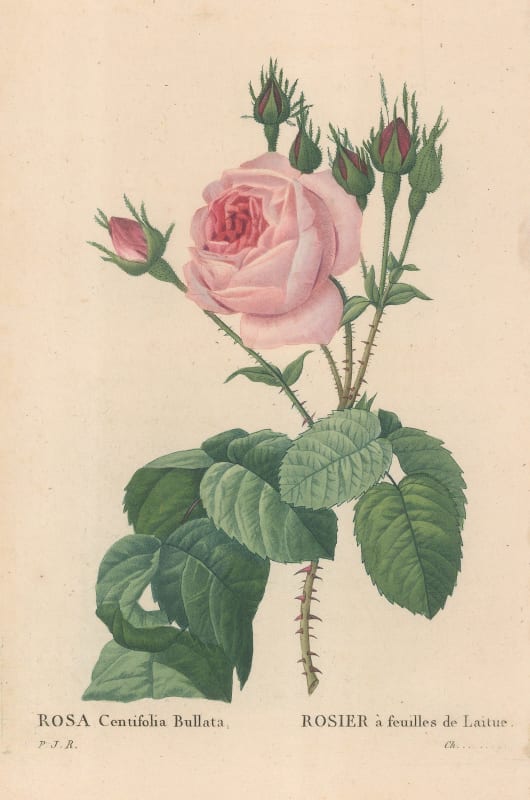Known as the ‘Raphael of flowers’, Pierre-Joseph Redoute served five queens and empresses of France, and is considered by many to be the greatest botanical artist known. Redoute started his career as an itinerant painter at the age of 13, travelling to the Low Countries where he was influenced by Flemish still lifes. Ten years later he moved to Paris to join his brother Antoine-Ferdinand as a set designer at the Theatre Italien, continuing his botanical studies in his spare time. Redoute became acquainted with the botanists Charles L’Heritier de Brutelle and Rene Desfontaines who schooled him in the systems of Carl Linneas, and the requirements of scientific illustration. L’Heritier was instrumental in his introduction to the court of Versailles and Marie Antoinette, who later appointed him peintre du cabinet de la reine.
In 1786 Redoute travelled to England to execute drawings for L’Hertier’s Sertum Anglicum working alongside the English artist James Sowerby. During his visit he met the engraver Francesco Bartolozzi, master of the technique of stipple engraving. First developed by the engraver to George III William Ryland, who was hanged for forgery in 1783, stipple engraving was almost exclusively used in England. The mixed method of etching and engraving allowed for greater variations in shades and softness produced through dots rather than lines, and would later become Redoute’s signature technique. On his return to Paris, Redoute continued providing illustrations for L’Hertier as well as studying under artist to the king at the Jardin du Roi, Gerard van Spaendorck, soon surpassing his tutor in terms of scientific and aesthetic skill.
Talented and resourceful Redoute navigated his way through the tumultuous years of the French Revolution, producing his first solo work for the botanist Augustin de Candolle’s Plantarum historia (1799), which was also the first to utilise hand coloured stipple-engraved plates. In that same year, Redoute with the botanist Etienne Ventenat also produced a work on the garden of botanist Jacques-Martin Cels. Ventenat’s brother Louis was naturalist and chaplain to the 1791 expedition to Australia led by Admiral Bruni Entrecasteaux, and through him Ventenat became employed by the Empress Josephine to whom he then introduced Redoute. Josephine had an interest in natural history and experimenting with agricultural improvement, and the vast greenhouses at Malmaison benefited greatly from her enthusiasm and France’s explorations. Malmaison became known for its varieties of cultivated plants particularly roses, her favourite flower. Redoute produced his first work for Josephine with Vetenet, Le Jardin de la Malmaison (1803-1805), then again with Vetenet Les Liliacees (1802-1816), and then with botanist Aime Bonpland, recently returned from five years with Alexander von Humboldt in the Americas, Description des plantes rares cultivees a Malmaison et a Navarre (1812-17).
After Josephine’s death in 1814, Redoute continued to visit the gardens of Malmaisson to focus on its roses, as well as those found in other grand gardens of France. His efforts culminated in his most famous work Les Roses in association with botanist Claude Thory, and issued in parts from 1817-24. Redoute struggled with funding for Les Roses having lost his most important patron, and throughout its production he was required to take on other work. His Album de Redoute 1824, a selection from Les Liliacees and Les Roses dedicated to the Duchesse de Berry the daughter in law of Charles X, did however bring him recognition. Charles X purchased the original water colours of Les Roses, and Redoute issued a quarto edition 1824-6. Soon Redoute would be under royal patronage, and again appointed pientre du cabinet de la reine. His love for his work undiminished, he was still painting when he died unexpectedly at eighty.
In Les Roses, Redoute exceled himself in his accuracy and subtle detailing, capturing the fresh, delicate vibrancy of the live plants from which he worked (rather than specimens), and his genuine understanding of the engraving technique itself. His precise, luminous renderings remain timeless, as fresh and lively as when he first painted them, making Les Roses the ultimate expression of one of the most gifted artists known to the genre.


